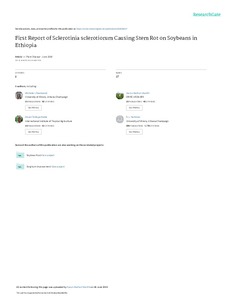| dc.contributor.author | Pawlowski, M.L. |
| dc.contributor.author | Murithi, H. |
| dc.contributor.author | Hailemariam, M. |
| dc.contributor.author | Abebe, A.T. |
| dc.contributor.author | Hartman, G.L. |
| dc.date.accessioned | 2020-06-04T11:50:24Z |
| dc.date.available | 2020-06-04T11:50:24Z |
| dc.date.issued | 2019 |
| dc.identifier.citation | Pawlowski, M.L., Murithi, H., Hailemariam, M., Abebe, A.T. & Hartman, G.L. (2019). First report of Sclerotinia sclerotiorum causing stem rot on soybean (Glycine max) in Ethiopia. Plant Disease, 1-2. |
| dc.identifier.issn | 0191-2917 |
| dc.identifier.uri | https://hdl.handle.net/20.500.12478/6860 |
| dc.description.abstract | Sclerotinia sclerotiorum causes a devastating disease on soybean (Sclerotinia stem rot) and attacks over 500 other hosts (Grau and Hartman 2015). In October 2018, research plots at Jimma Agricultural Research Center, Ethiopia, were evaluated for soybean diseases. A sample of 100 randomly selected plants of soybean line T44-15-T110-16SH1 were evaluated for Sclerotinia stem rot in a research plot that was 4 × 2.4 m with 60 cm between the four rows and 5 cm between plants within a row. All but 16 stems had stem rot symptoms with an average plant severity rating of 3.5 (SE = 0.18) based on an adapted 1 (1 to 10% of the stem affected) to 5 (91 to 100% of the stem affected) rating scale (Little and Hills 1978). Five infected stems were selected and sent to the USDA-ARS Soybean Disease and Pest Research Laboratory, Urbana, IL. Three sclerotia removed from each of three infected stems ranged from 4 to 18 mm long and 1 to 2 mm wide. Sclerotia were placed on potato dextrose agar (PDA) in 9.8-cm-diameter Petri plates and incubated at 24°C with a 16-h photoperiod for 4 days. The white, appressed mycelia grew from the sclerotia and covered the entire plate after 48 h, with sclerotia forming on the edge of the plate by 4 days. To confirm pathogenicity, a mycelial plug was removed from the margin of a 2-day-old colony of one of the isolates, was obtained by pressing the large end of a 200-μl pipette tip into the culture, and was placed on top of a cut stem above the second trifoliolate of four 3-week-old plants of soybean cultivar Williams 82. Plants were then incubated in a moist chamber for 48 h prior to being placed in a greenhouse held at 22°C with a 16-h photoperiod. Necrotic lesions and white mycelia appeared on the stems 4 days postinoculation. The pathogen was reisolated and cultured on PDA. After 4 days, the reisolated cultures with sclerotia appeared morphologically to be S. sclerotiorum. |
| dc.format.extent | 1-2 |
| dc.language.iso | en |
| dc.subject | Sclerotinia Sclerotiorum |
| dc.subject | Soybeans |
| dc.subject | Diseases |
| dc.subject | Disease Control |
| dc.subject | Plant Diseases |
| dc.title | First report of Sclerotinia sclerotiorum causing stem rot on soybean (Glycine max) in Ethiopia |
| dc.type | Journal Article |
| cg.contributor.crp | Grain Legumes |
| cg.contributor.affiliation | University of Illinois |
| cg.contributor.affiliation | International Institute of Tropical Agriculture |
| cg.contributor.affiliation | Jimma Agricultural Research Center, Ethiopia |
| cg.contributor.affiliation | United States Department of Agriculture |
| cg.coverage.region | Africa |
| cg.coverage.region | East Africa |
| cg.coverage.country | Ethiopia |
| cg.coverage.hub | Headquarters and Western Africa Hub |
| cg.researchtheme | Natural Resource Management |
| cg.identifier.bibtexciteid | PAWLOWSKI:2019 |
| cg.isijournal | ISI Journal |
| cg.authorship.types | CGIAR and developing country institute |
| cg.iitasubject | Agronomy |
| cg.iitasubject | Grain Legumes |
| cg.iitasubject | Plant Breeding |
| cg.iitasubject | Plant Diseases |
| cg.iitasubject | Plant Health |
| cg.iitasubject | Plant Production |
| cg.iitasubject | Soybean |
| cg.journal | Plant Disease |
| cg.notes | Open Access Article; Published online: 18 June 2019 |
| cg.accessibilitystatus | Open Access |
| cg.reviewstatus | Peer Review |
| cg.usagerightslicense | Creative Commons Attribution 4.0 (CC BY 0.0) |
| cg.targetaudience | Scientists |
| cg.identifier.doi | https://dx.doi.org/10.1094/pdis-05-19-0929-pdn |
| cg.iitaauthor.identifier | HARUN MURITHI: 0000-0003-1113-8729 |

